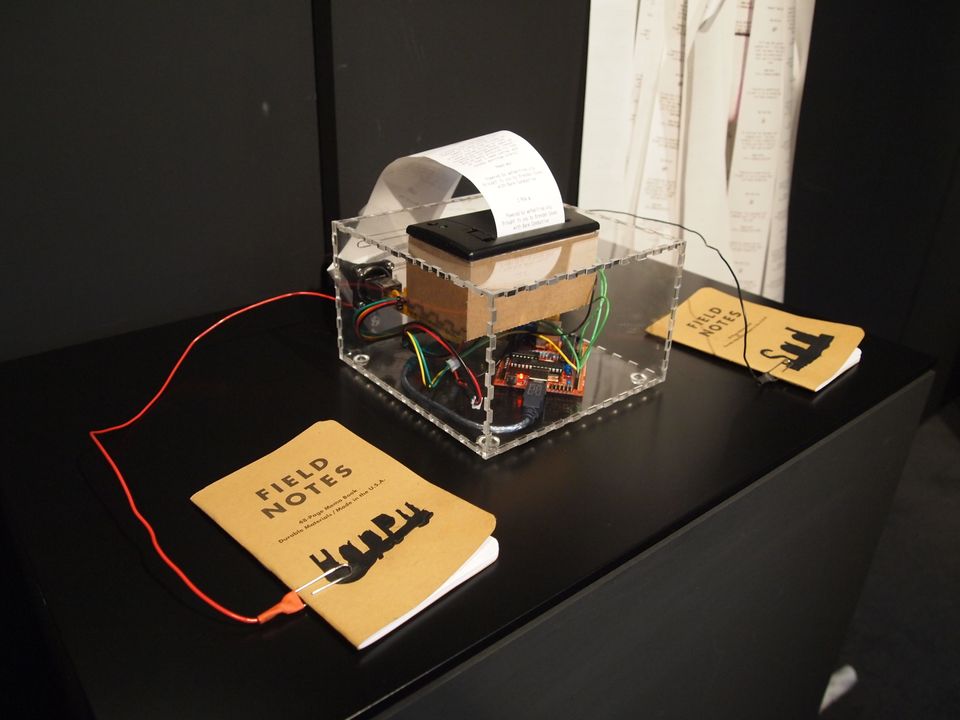
Want a little bit more happiness in your life? Well, search no further. “Digital artist, designer, author and maker” Brendan Dawes has invented the world’s first “Happiness Machine,” a little printer that 1) searches the internet for things people said while they were happy and, 2) prints out one of those things each time you press the “print” button.
Shown at the London Design Festival 2012, the Happiness Machine has a homely old-fashioned appearance. The tiny black printer radiates exposed wires and prints words of “happiness” on little paper slips that look like receipts. (See slideshow below for photos of the device.) Writing about the machine on his website, Dawes says, “I still believe paper has advantages from time to time as a content delivery mechanism over all the screens that now pervade our lives; you can tear it off, put it in your wallet/purse, scribble on it, or give it someone else without worrying whether it works with their OS. And it doesn’t need a power source for display.”
But primitive as the Happiness Machine may seem, Dawes is no newcomer to the wild world of high-tech art. Working as a creative director for magneticNorth, he brainstormed “digital design solutions for clients that included BBC, Diesel, Reuters, Astra Zeneca, Kellogs, Fox Kids, Channel 4, Arup and Coca-Cola” while making art from eclectic analog and digital materials “on the side.” Via email he describes his MoMA-featured projects, like Cinema Redux (a “print piece that shows a visual summary of of an entire movie, second by second, minute by minute”) and DoodleBuzz (“an interface I created specifically to allow people a more serendipitous journey through the news”), which eventually gained him fame enough to quit his day job. Now, he says, he makes art and plays with his Makerbot 3D printer “full-time.”
Dawes emailed with the Huffington Post to chat about art, life, the Happiness Machine and his decision to design something deliberately seeming-analog.
Tell me about yourself, and some of the art you've done before this.
I've been making things with computers since the early eighties[,] ever since I got hooked on Asteroids at my local video arcade. Never studied either design or computers at college[,] as I never went to college or University. Instead I got into compiling underground breakbeat albums for a record label in London, scouring the local second-hand record shops for various beats. Eventually I signed a record contract for a label in Liverpool and put out a few records during the rave scene -- earned no money at all, but did get into the top ten of some club charts! Then I discovered this thing called the web, taught myself Photoshop and a few other things...[now] I'm putting combinations of things together to see what appears, what works and what resonates with people.
What gave you the idea for the Happiness Machine?
It's very easy to forget that behind that Twitter username or blog post sits a human being, a human-being with feelings and emotions. For me the Internet is a network of people, not machines, so I wanted something that remind us of that. A button on top of a machine that prints out feelings from strangers connected through the net. You hold it in your hands and it feels real.
A lot of your art is very high-tech, but this machine seems fairly analogue -- it prints like a receipt printer, one message at a time, on little pieces of paper, with naked wires emerging from the machine. Why did you design the Happiness Machine this way, as opposed to something more obviously high-tech?
There's a lovely sense of expectation when you hit the button and it begins to print; what will it say, who will it be? Often times things on-screen can be devoid of these important pieces of expectant punctuation...As for the wires and the transparent nature of the box, I wanted it to be the antithesis of the closed approach that we see so much of with the tech we buy. It's saying, "here I am, I'm see-through, this is how I work, take me apart." I wanted it to be an invitation to create something else. Right now it's a happiness machine, but you could take it all apart and it easily be something else.
What have people's reactions to the machine been? What's been the most interesting reaction?
I'm constantly surprised by the reaction people have to it. A lot of people want to have one themselves, which seems to suggest that many people need a little bit of happiness in their lives. Or it reminds them about the connected nature of all of us, in a world that often seems lonely. Here is a machine whose sole purpose is to deliver a feeling. It's not trying to sell you something you don't really need, it just is what it is. I think there's an honesty to it which I think people seem to really love. I remember watching someone use it at the London Design Festival and they first of all jumped when they hit the button and the printer cranked into action, but then smiled when they saw what came out of it.
Have people been hesitant to tear off the messages, or have they done it? Do you let them?
I'd love people to tear them off but most don't. I think culturally for a long time we've been told "do not touch" and so people are afraid to touch it. I think I need to put a little message on there to encourage people to tear it off and take it away.
